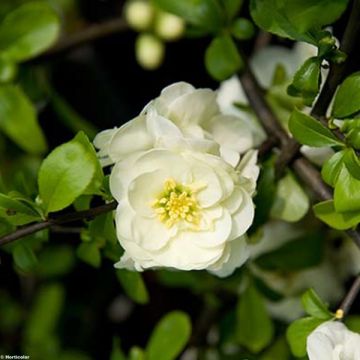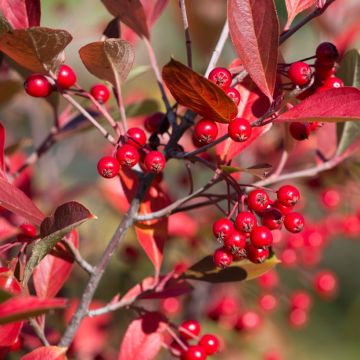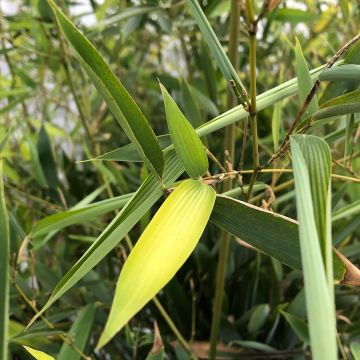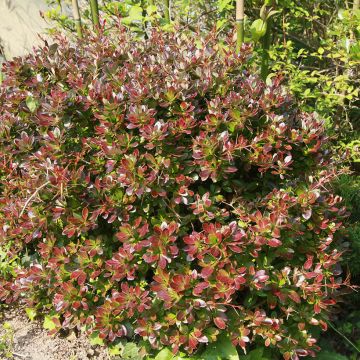

Pseudocydonia sinensis


Pseudocydonia sinensis


Pseudocydonia sinensis


Pseudocydonia sinensis


Pseudocydonia sinensis


Pseudocydonia sinensis


Pseudocydonia sinensis


Pseudocydonia sinensis
Pseudocydonia sinensis
Pseudocydonia sinensis
Chinese Quince
Very beautiful young plant.
Estelle, 24/09/2025
Special offer!
Receive a €20 voucher for any order over €90 (excluding delivery costs, credit notes, and plastic-free options)!
1- Add your favorite plants to your cart.
2- Once you have reached €90, confirm your order (you can even choose the delivery date!).
3- As soon as your order is shipped, you will receive an email containing your voucher code, valid for 3 months (90 days).
Your voucher is unique and can only be used once, for any order with a minimum value of €20, excluding delivery costs.
Can be combined with other current offers, non-divisible and non-refundable.
Home or relay delivery (depending on size and destination)
Schedule delivery date,
and select date in basket
This plant carries a 24 months recovery warranty
More information
We guarantee the quality of our plants for a full growing cycle, and will replace at our expense any plant that fails to recover under normal climatic and planting conditions.
Would this plant suit my garden?
Set up your Plantfit profile →
Description
One wonders why Pseudocydonia sinensis, also known as the Chinese Quince, is not more commonly planted in our gardens, given its countless qualities. Perhaps it is due to its reputation as a frost-sensitive plant that has preceded it since the end of the 19th century. This large, thornless shrub has since proven its ability to survive very cold winters if the conditions are met. It offers permanent appeal, through its beautiful bark, its pink spring flowering followed by large edible and fragrant quinces, not to mention its incandescent autumn colours, which provide a spectacle until late in the season. It is a remarkable plant: superb, fruitful, and robust, it undoubtedly deserves to be tried in ornamental gardens, or even in orchards. Its only requirement: long hot summers that allow for good fruit ripening and significantly improve its cold resistance.
Pseudocydonia sinensis is a small tree or large shrub of the Rosaceae family, with rather slow growth. It is the only species in the Pseudocydonia genus. It is native to the southeastern provinces of China, where it grows up to 1000 m (3280 ft) in altitude. Pseudocydonia can be distinguished from Cydonia, the quince tree in our orchards, by its shiny leaves that are finely toothed at the edges, as well as the absence of thorns, its solitary flowers instead of clusters, and its much larger and perfectly smooth, fuzz-free fruits. The hardiness of this plant will be better in a continental climate or in regions that experience long hot summers and a beautiful late season: the heat allows the branches to lignify well before winter arrives.
The Chinese Quince often forms several trunks supporting a bushy and spreading crown, but it can easily be trained into a single-trunk small tree through appropriate pruning. Over time, it is not uncommon for a single trunk to dominate the others. At maturity, it will reach an average height of 5 m (16 ft 5 in) with a spread of 3.5 m (11 ft 6 in). Its bark is highly decorative: it peels off in plates in June, with large pieces of reddish bark gradually detaching and falling to the ground. The bark, which is grey-brown in colour, reveals large orange areas, decorative throughout the year.
The leaves develop before the flowers; they are alternate, thick, oval-lanceolate in shape, 5 to 8 cm (2 to 3.1 in) long and 3 to 5 cm (1.2 to 2 in) wide, with finely toothed margins. They are a bright green colour and have a shiny upper surface. The autumn colours are fantastic, ranging from orange to red and purple, enhanced by the glossy appearance of the lamina. Completely deciduous in very cold climates, the leaves of this quince can persist through winter in sheltered locations or mild climates. They remain attached to the branches for a long time, sometimes until the new leaves appear in spring. The sight of yellow quinces mixed with flamboyant foliage is superb in October-November.
Flowering on Pseudocydonia sinensis occurs from April to May, lasting about 3 to 4 weeks. The flowers, highly nectar-rich and honey-producing, reach 3 to 5 cm (1.2 to 2 in) in diameter. They are composed of 5 concave petals forming a cup, with a shade of pink that varies depending on the individual. Each flower opens to reveal a heart of yellow stamens. The flowers are solitary and borne on the previous year's branches. They are self-fertile, and a single Pseudocydonia plant is enough to produce fruits. After the flowers, large oval fruits called Chinese quinces appear, initially green and becoming yellow and smooth when ripe. Each fruit measures up to 20 cm (7.9 in) long. They are edible after cooking. The fruits of this quince tree are particularly fragrant, and their flesh is highly aromatic. They are harvested from October to December depending on the region and can be consumed in the same way as the quinces we are familiar with: in compotes, jellies, fruit pastes, or even in tagines.
The Chinese Quince is a plant of great ornamental value and quite tolerant, but it thrives particularly well in a variety of contrasting climates. While it loves heat and sun, this shrub can adapt to all types of soil (acidic, calcareous, clayey, heavy, humiferous, loamy) that do not retain excessive water. Once well established in deep soil, it can even tolerate summer drought. It can be planted in ornamental gardens or orchards. Choose a prominent location for it, so you can admire its charms that impress throughout the year. Pseudocydonia sinensis can, for example, be combined in a large hedgerow with Tetradium danielii (the bee tree), Parrotia persica, small maples (monspessulanum, griseum, truncatum, palmatum dissectum), botanical roses (Rosa hugonis, moyesii, complicata, etc.), deciduous euonymus, Paul's Scarlet hawthorn, and many others. Placing a single fruit in a bowl will pleasantly perfume your living room or dining room! It can also be grown as a bonsai.
Uses and properties:
Chinese quinces are traditionally used in Chinese and Japanese medicine in the form of syrup and drinks to treat sore throats. Koreans also attribute medicinal properties to them and use them to treat tuberculosis and asthma.
In cooking: to make jellies, add pectin because the naturally occurring pectin in the seeds is not sufficient to gel the preparation.
Report an error about the product description
Pseudocydonia sinensis in pictures








Plant habit
Flowering
Foliage
Botanical data
Pseudocydonia
sinensis
Rosaceae
Chinese Quince
China
Other Chaenomeles - Quince tree
View all →Planting and care
Pseudocydonia sinensis is preferably planted in spring in colder regions, and in early autumn in mild climates. It thrives preferably in the sun, where it shows more flowers and more colour in autumn. Plant it in ordinary, deep, well-prepared soil enriched with leaf compost. It requires well-drained soil and prefers it to remain slightly moist, even though it tolerates drought well after 3 years of cultivation. It is a very easy plant to grow that tolerates a wide range of soils, as long as they do not retain excessive water in winter and are not too dry in summer. It tolerates clayey and heavy soils and limestone, but prefers humus-rich soils. Acidic or sandy soils are not a problem if they remain moist and are not too poor. Water regularly to ensure it establishes itself properly. During the first two summers, if it is dry, provide 20 litres of water every two weeks and mulch the soil (10 to 20 cm (3.9 to 7.9 in) thick) to retain freshness. This quince tree requires little maintenance, apart from pruning the lower branches to highlight its beautiful bark. You can also remove surplus trunks on young plants. There was a time when marketing this shrub was prohibited due to its alleged sensitivity to fire blight: this regulation has now become completely obsolete.
Planting period
Intended location
Care
-
, onOrder confirmed
Reply from on Promesse de fleurs
Similar products
Haven't found what you were looking for?
Hardiness is the lowest winter temperature a plant can endure without suffering serious damage or even dying. However, hardiness is affected by location (a sheltered area, such as a patio), protection (winter cover) and soil type (hardiness is improved by well-drained soil).

Photo Sharing Terms & Conditions
In order to encourage gardeners to interact and share their experiences, Promesse de fleurs offers various media enabling content to be uploaded onto its Site - in particular via the ‘Photo sharing’ module.
The User agrees to refrain from:
- Posting any content that is illegal, prejudicial, insulting, racist, inciteful to hatred, revisionist, contrary to public decency, that infringes on privacy or on the privacy rights of third parties, in particular the publicity rights of persons and goods, intellectual property rights, or the right to privacy.
- Submitting content on behalf of a third party;
- Impersonate the identity of a third party and/or publish any personal information about a third party;
In general, the User undertakes to refrain from any unethical behaviour.
All Content (in particular text, comments, files, images, photos, videos, creative works, etc.), which may be subject to property or intellectual property rights, image or other private rights, shall remain the property of the User, subject to the limited rights granted by the terms of the licence granted by Promesse de fleurs as stated below. Users are at liberty to publish or not to publish such Content on the Site, notably via the ‘Photo Sharing’ facility, and accept that this Content shall be made public and freely accessible, notably on the Internet.
Users further acknowledge, undertake to have ,and guarantee that they hold all necessary rights and permissions to publish such material on the Site, in particular with regard to the legislation in force pertaining to any privacy, property, intellectual property, image, or contractual rights, or rights of any other nature. By publishing such Content on the Site, Users acknowledge accepting full liability as publishers of the Content within the meaning of the law, and grant Promesse de fleurs, free of charge, an inclusive, worldwide licence for the said Content for the entire duration of its publication, including all reproduction, representation, up/downloading, displaying, performing, transmission, and storage rights.
Users also grant permission for their name to be linked to the Content and accept that this link may not always be made available.
By engaging in posting material, Users consent to their Content becoming automatically accessible on the Internet, in particular on other sites and/or blogs and/or web pages of the Promesse de fleurs site, including in particular social pages and the Promesse de fleurs catalogue.
Users may secure the removal of entrusted content free of charge by issuing a simple request via our contact form.
The flowering period indicated on our website applies to countries and regions located in USDA zone 8 (France, the United Kingdom, Ireland, the Netherlands, etc.)
It will vary according to where you live:
- In zones 9 to 10 (Italy, Spain, Greece, etc.), flowering will occur about 2 to 4 weeks earlier.
- In zones 6 to 7 (Germany, Poland, Slovenia, and lower mountainous regions), flowering will be delayed by 2 to 3 weeks.
- In zone 5 (Central Europe, Scandinavia), blooming will be delayed by 3 to 5 weeks.
In temperate climates, pruning of spring-flowering shrubs (forsythia, spireas, etc.) should be done just after flowering.
Pruning of summer-flowering shrubs (Indian Lilac, Perovskia, etc.) can be done in winter or spring.
In cold regions as well as with frost-sensitive plants, avoid pruning too early when severe frosts may still occur.
The planting period indicated on our website applies to countries and regions located in USDA zone 8 (France, United Kingdom, Ireland, Netherlands).
It will vary according to where you live:
- In Mediterranean zones (Marseille, Madrid, Milan, etc.), autumn and winter are the best planting periods.
- In continental zones (Strasbourg, Munich, Vienna, etc.), delay planting by 2 to 3 weeks in spring and bring it forward by 2 to 4 weeks in autumn.
- In mountainous regions (the Alps, Pyrenees, Carpathians, etc.), it is best to plant in late spring (May-June) or late summer (August-September).
The harvesting period indicated on our website applies to countries and regions in USDA zone 8 (France, England, Ireland, the Netherlands).
In colder areas (Scandinavia, Poland, Austria...) fruit and vegetable harvests are likely to be delayed by 3-4 weeks.
In warmer areas (Italy, Spain, Greece, etc.), harvesting will probably take place earlier, depending on weather conditions.
The sowing periods indicated on our website apply to countries and regions within USDA Zone 8 (France, UK, Ireland, Netherlands).
In colder areas (Scandinavia, Poland, Austria...), delay any outdoor sowing by 3-4 weeks, or sow under glass.
In warmer climes (Italy, Spain, Greece, etc.), bring outdoor sowing forward by a few weeks.


















































